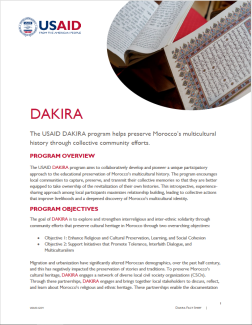The USAID DAKIRA program helps preserve Morocco’s multicultural history through collective community efforts.
PROGRAM OVERVIEW
The USAID DAKIRA program aims to collaboratively develop and pioneer a unique participatory approach to the educational preservation of Morocco’s multicultural history. The program encourages local communities to capture, preserve, and transmit their collective memories so that they are better equipped to take ownership of the revitalization of their own histories. This introspective, experience-sharing approach among local participants maximizes relationship building, leading to collective actions that improve livelihoods and a deepened discovery of Morocco’s multicultural identity.
PROGRAM OBJECTIVES
The goal of the USAID Dakira Program is to explore and strengthen interreligious and inter-ethnic solidarity through community efforts that preserve cultural heritage in Morocco through two overarching objectives:
Objective 1: Enhance Religious and Cultural Preservation, Learning, and Social Cohesion
Objective 2: Support Initiatives that Promote Tolerance, Interfaith Dialogue, and Multiculturalism
Migration and urbanization have significantly altered Moroccan demographics over the past half century, and this has negatively impacted the preservation of stories and traditions. To preserve Morocco’s cultural heritage, DAKIRA engages a network of diverse local civil society organizations. Through these partnerships, DAKIRA engages and brings together local stakeholders to discuss, reflect, and learn about Morocco’s religious and ethnic heritage. These partnerships enable the documentation and dissemination of stakeholder practices and testimonies, along with the restoration of tangible heritage.
The program develops and implements an integrated and participatory approach focused on empowering communities through capacity building and experiential learning to promote multiculturalism, social cohesion, and diversity, creating shared plans of action for improving future livelihood opportunities within the targeted communities.
RESULTS ACHIEVED
Enabled 175 religious and cultural heritage sites to be identified, evaluated, and mapped in various regions of Morocco, in partnership with the American Society for Overseas Research
Created over 50 educational and outreach tools for facilitators and participants of interfaith dialogue initiatives, including tour guides, students, and CSOs
Engaged more than 150 schools and 1,500 youth in heritage learning activities
Pioneered Moroccan Jewish heritage and Hebrew language learning for over 400 tour guides, youth, and Master's-level students
Facilitated more than 20 heritage preservation capacity-building sessions with more than 220 civil society and community members in six regions of Morocco
Engaged over 1,000 community members in intercultural, interreligious, and intergenerational community dialogue from Tangier, Salé, Fes, Meknes, Sefrou, Tiznit, Taroudant
Supported the digitization of the archives of the Catholic Diocese of Rabat from 1890 onwards, which represents 70,000 personal files, 80,000 pages of registry records, more than 5,000 administrative documents, and 10,000 pages of magazines and reviews
FACTS AND FIGURES
IMPLEMENTING PARTNER
The High Atlas Foundation
HOST COUNTRY PARTNERS
- The Ministry of Youth, Culture, and Communication
- The Ministry of Tourism
- The International Institute of Tourism of Tangier
- Local Civil Society Organizations
LOCATION
Casablanca/El Jadida, Tangier/Tetouan/Al Hoceima, Marrakech/Safi, Fes/Meknes regions
TOTAL BUDGET AND DURATION
$3 million, July 2021 – June 2024
KEY CONTACT
Idriss Touijer
Senior Development Specialist
USAID/Morocco
itouijer@usaid.gov


